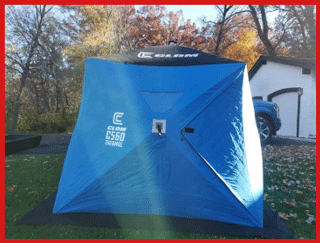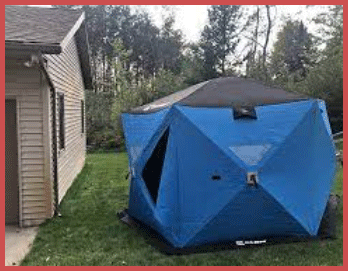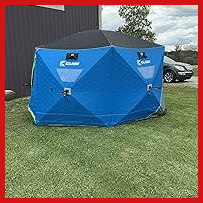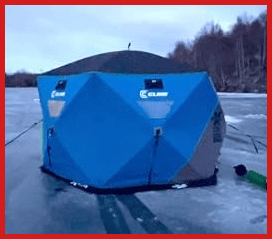Picture this: you’re out on a frozen lake, the wind’s howling, but you’re cozy, warm, and hauling in fish with your buddies. That’s the magic of the Clam C-560 Thermal Hub Ice Shelter, and trust me, it’s a game-changer for ice fishing. I’ve spent countless hours in this shelter, and I’m here to spill the beans on why it’s worth every penny. From setup to showdowns with other brands, I’ll walk you through my experience, tips, and more. Ready to elevate your ice fishing? Grab the C-560 and join the fun!
My Journey With The Clam C-560 Thermal Hub
When I first got into ice fishing, I was that guy shivering in a flimsy pop-up tent, questioning my life choices. Then I upgraded to the Clam C-560 Thermal Hub, and it’s been a love story ever since. This shelter is designed for 3-4 anglers, boasts 56 square feet of fishable space, and sets up in about 60 seconds. Its thermal skin keeps you toasty, and the 80-inch center height lets you stand up without hunching. I’ve taken it on solo trips and group outings, and it’s never let me down. Let’s dive into what makes it shine (and where it stumbles).
Pros Of The Clam C-560 Thermal Hub

The C-560 is a beast, and I’m not just saying that because I’m obsessed with ice fishing. Here’s why it’s earned a permanent spot in my gear lineup:
- Quick Setup: You can pop this thing up in under a minute. I’ve timed it—60 seconds flat, even in gloves. It’s a lifesaver when you’re racing against a freezing wind.
- Thermal Insulation: The 600-denier fabric with 60 grams of insulation per square meter keeps heat in and condensation out. I’ve stayed warm in -20°F with just a small heater.
- Spacious Interior: At 90×90 inches, it fits 3-4 anglers comfortably. I’ve had three buddies, gear, and a heater inside, and we weren’t tripping over each other.
- Tall Center Height: The 80-inch height is a godsend. I’m 6’2”, and standing up to stretch or fight a fish without smacking my head is pure bliss.
- Portable Design: It packs down to 65x11x11 inches and weighs 40 pounds. I toss it in my truck bed solo, no sweat, despite its size.
- Sturdy Poles: The flex-tested 11mm poles hold up against brutal winds. I’ve weathered 30 mph gusts, and the C-560 didn’t budge.
- Oversized Skirt: The skirt makes snow banking a breeze, sealing out drafts. I pile snow around it, and it’s like a fortress against the cold.
- Included Accessories: Ice anchors and tie ropes come standard. They’re solid, and I’ve never had to replace them, even after heavy use.
- Triple-Layer Corner Pockets: These are perfect for stashing small gear like lures or snacks. I keep my essentials handy without cluttering the floor.
- Durable Fabric: The 600-denier material is tough as nails. I’ve dragged it over rough ice, and it’s still free of tears or fraying.
Every time I set up the C-560, I’m reminded how it balances comfort and convenience. It’s like a cozy cabin on the ice, and I’ve had some of my best fishing days inside it.
Cons Of The Clam C-560 Thermal Hub
No gear is perfect, and the C-560 has its quirks. Here’s where it falls short, based on my experience:
Also Read: My Thought on ReelYaks Raptor Modular Fishing Kayak Review
- Non-Removable Windows: The windows don’t open, which can limit ventilation. On milder days, I’ve had to crack the door to avoid overheating.
- Zipper Issues: The zippers can be finicky, especially in extreme cold. I’ve had one stick, and replacing it was a hassle I didn’t need.
- Weak Stock Anchors: The included anchors work, but they’re not bombproof. In high winds, I’ve upgraded to heavier ones to avoid a runaway tent.
- No Floor: Like most hub shelters, it lacks a built-in floor. I use foam mats, but puddles from melting snow can be a pain.
- Bulky When Packed: At 40 pounds, it’s manageable but not lightweight. If you’re trekking far, you’ll feel the weight on your sled.
- Limited Door Design: The door isn’t full-length, which can make entry tricky with bulky gear. I’ve fumbled getting my auger inside.
- Condensation in Warm Weather: Despite the thermal skin, condensation can build up on milder days. I bring a towel to wipe down the interior.
- Price Point: It’s not the cheapest hub out there. I paid around $350, and while it’s worth it, budget anglers might flinch.
- Window Placement: The windows are oddly positioned for checking outside. I often step out to scout rather than rely on them.
- Bag Size: The carry bag is snug. If the shelter’s icy, good luck stuffing it back in without a fight—I’ve cursed it a few times.
These gripes haven’t stopped me from loving the C-560, but they’re worth knowing. With some tweaks (like better anchors), you can work around most of them.
Maintenance And Tips To Get The Most Out Of Your C-560

To keep your C-560 in top shape and maximize its performance, a little TLC goes a long way. Here’s how I’ve kept mine fishing-ready:
- Dry It Out: Always air-dry the shelter after use to prevent mold. I set it up in my garage for a day to let moisture evaporate.
- Lubricate Zippers: Use silicone spray on the zippers to keep them smooth. I do this monthly, and it’s saved me from stuck zippers.
- Upgrade Anchors: Swap the stock anchors for heavy-duty ones. I use 8-inch spiral anchors, and they hold like a dream in windy conditions.
- Add Foam Mats: Lay down 24×24-inch foam mats for insulation and dryness. They’re a game-changer for keeping your feet warm and dry.
- Use a Carbon Monoxide Detector: With a heater inside, safety is key. I clip a detector to the hub frame for peace of mind.
- Snow Bank Properly: Pile snow high around the skirt to seal drafts. I spend an extra five minutes banking, and it keeps the interior toasty.
- Store Properly: Keep it in a dry, cool place offseason. I store mine in a plastic bin to protect it from dust and critters.
- Clean Stains Gently: Spot-clean with diluted soap and a soft cloth. I’ve removed fish slime without damaging the fabric this way.
- Check Poles: Inspect the 11mm poles for cracks before each season. I’ve caught small stress marks early and avoided mid-trip failures.
- Vent Strategically: Crack the door slightly for airflow on warmer days. I prop it with a small bungee to balance heat and ventilation.
These habits have kept my C-560 in near-mint condition after three seasons. Treat it right, and it’ll be your ice fishing buddy for years.
Comparison With Other Brands

The C-560 is awesome, but how does it stack up against the competition? I’ve used or researched other top brands, and here’s a head-to-head breakdown.
Clam C-560 vs. Eskimo Outbreak 450XD
- Size: The C-560’s 56 square feet beats the 450XD’s 51 square feet. I fit more gear in the Clam, but the Eskimo feels roomy for three.
- Insulation: Both are insulated, but the C-560’s 600-denier fabric feels warmer. The Eskimo’s quilted canvas is solid but less heat-retentive.
- Door: The 450XD’s full-length door is a winner. I find it easier to haul gear in compared to the C-560’s smaller entry.
- Windows: Eskimo’s removable windows allow ventilation, unlike the C-560’s fixed ones. I envy that feature on stuffy days.
- Weight: The C-560 (40 lbs) is lighter than the 450XD (48 lbs). I prefer the Clam for long hauls across the ice.
- Setup: Both pop up in about 60 seconds. I’ve set up each in wind, and they’re equally user-friendly.
- Durability: The C-560’s 11mm poles feel sturdier than the Eskimo’s. I’ve seen Eskimo poles bend in gusts where the Clam held firm.
- Price: The 450XD is often $50 cheaper. If budget’s tight, the Eskimo’s a great value, but I’d still pick the C-560 for warmth.
- Anchors: Eskimo’s anchors are slightly better out of the box. I’ve had to chase the C-560 in wind before upgrading mine.
- Bag: The 450XD’s oversized bag is easier to pack than the C-560’s snug one. I struggle less with the Eskimo post-trip.
I lean toward the C-560 for its warmth and space, but the 450XD’s door and ventilation make it a close contender.
Clam C-560 vs. Otter Vortex Pro Resort
- Size: The Otter’s 75 square feet dwarfs the C-560’s 56. I’ve used the Otter for big groups, and it’s a palace, but overkill for three.
- Insulation: Both have thermal fabrics, but Otter’s feels thicker. I notice less condensation in the Otter on warm days.
- Weight: At 50 pounds, the Otter’s heavier than the C-560 (40 lbs). I feel the difference dragging it across the ice.
- Setup: The Otter takes a bit longer—about 90 seconds. The C-560’s quicker setup wins when I’m eager to fish.
- Poles: Otter’s poles are beefy but less flexible than the C-560’s 11mm ones. I’ve seen Otter hubs snap in high winds.
- Price: The Otter costs $100+ more. I love its features, but the C-560 delivers similar performance for less.
- Durability: Otter’s canvas is water-resistant but not waterproof, like the C-560. Both hold up well, but I’ve had no tears in either.
- Accessories: The Otter includes a better carry bag. I find the C-560’s bag too tight, especially when wet.
- Windows: Otter’s windows are larger and openable. I prefer them for scouting fish compared to the C-560’s fixed ones.
- Portability: The C-560’s lighter weight and smaller pack size make it easier to transport. The Otter’s bulkier for solo trips.
The Otter’s spacious, but the C-560’s portability and price make it my go-to for most outings.
Clam C-560 vs. Frabill Fortress 260

- Size: The Frabill’s 48 square feet is smaller than the C-560’s 56. I feel cramped in the Frabill with three anglers.
- Insulation: The C-560’s thermal skin outperforms the Frabill’s lighter insulation. I stay warmer in the Clam on frigid nights.
- Weight: Frabill’s 38 pounds is slightly lighter than the C-560’s 40. I barely notice the difference on my sled.
- Setup: Both set up in under a minute. I’ve raced buddies with the Frabill, and it’s neck-and-neck with the C-560.
- Poles: The C-560’s 11mm poles are tougher than Frabill’s thinner ones. I’ve seen Frabill hubs wobble in wind.
- Price: Frabill’s often $30 cheaper. It’s a budget-friendly pick, but I’d spend the extra for the C-560’s warmth.
- Windows: Frabill’s windows open, unlike the C-560’s. I like the ventilation but miss the C-560’s sturdier feel.
- Durability: Both fabrics are tough, but the C-560’s 600-denier feels thicker. I’ve scraped both, and the Clam looks newer.
- Anchors: Frabill’s anchors are decent but bend easier than the C-560’s. I’ve replaced Frabill’s sooner.
- Comfort: The C-560’s taller height (80 inches) beats Frabill’s 75 inches. I can stand fully in the Clam, which seals the deal.
The C-560’s warmth and space edge out the Frabill, though the Fortress is a solid budget option.
My Ice Fishing Adventures With The C-560
I’ve had some epic days with the C-560. One trip stands out: a February weekend on Lake Minnetonka with three buddies. We set up in -15°F, and the shelter was a sauna with just a small propane heater. We drilled four holes, spread out, and pulled in walleye like nobody’s business. The 80-inch height let us stand to jig, and the triple-layer pockets kept our lures organized. Sure, the windows didn’t open, so we cracked the door for air, but the thermal skin kept condensation minimal. Another time, I went solo on a small lake, and the quick setup meant I was fishing in minutes. Even when a gusty storm rolled in, the 11mm poles and snow-banked skirt held firm. These moments make the C-560 my ride-or-die.
How To Optimize Your C-560 Experience
Want to take your C-560 to the next level? Here’s how I squeeze every ounce of awesome out of it:
- Pack Smart: Use a sled to haul it. I stack my auger, heater, and C-560 on a sled, and it’s a breeze to move.
- Add Lighting: Clip LED lanterns to the hub frame. I use two for bright, even light during night fishing.
- Organize Gear: Bring a small folding table for electronics. I set up my fish finder and phone charger without cluttering the floor.
- Insulate More: Layer a tarp under foam mats for extra warmth. I’ve cut heat loss significantly this way.
- Heater Placement: Position your heater centrally but low. I keep mine off the ice to avoid melting puddles.
- Drill Strategically: Space holes evenly inside. I mark four spots before drilling to maximize fishing space.
- Stay Mobile: Move the shelter if the fish aren’t biting. The quick setup lets me relocate in under 10 minutes.
- Bring Extras: Pack spare anchors and bungees. I’ve used them to secure the C-560 in unexpected storms.
- Ventilation Hack: Use a small fan to circulate air. I clip one to the frame to reduce condensation.
- Comfort First: Add folding chairs. I bring lightweight ones for long sessions, and my back thanks me.
These tweaks have turned my C-560 into a fishing command center. You’ll wonder how you ever fished without them.
Frequently Asked Questions (Faq)
Yes, the C-560 is insulated! Its full thermal skin uses 600-denier fabric with 60 grams of insulation per square meter. I’ve stayed warm in subzero temps, and it cuts condensation better than non-thermal hubs
It’s tough to crown one champ, but Clam’s X-400 and Otter’s XT Pro X-Over are top dogs. I’ve used the X-400, and its 68 square feet and thermal fabric are unreal for two anglers. Otter’s durability is a close second. Pick based on size and budget
Clam shelters, including the C-560, are water-resistant, not fully waterproof. The 600-denier fabric handles light snow and rain, but prolonged exposure can let water seep through. I always bank snow around the skirt to minimize leaks.
Yes, the Clam Nanook XL Thermal is insulated with a full thermal skin, similar to the C-560. It’s got 600-denier fabric and keeps you toasty for one or two anglers. I’ve heard it’s a beast for solo trips.
Why The Clam C-560 Is Your Next Must-Have
Also Read: My Thought on ReelYaks Raptor Modular Fishing Kayak Review
After three seasons with the Clam C-560 Thermal Hub, I’m hooked. It’s warm, spacious, and built for epic ice fishing adventures. Whether you’re solo or with buddies, its quick setup and sturdy design make every trip a blast. Sure, it’s got quirks, but with my tips, you’ll conquer them.
